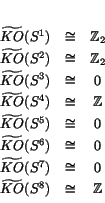3.2
We already touched upon Bott periodicity when we mentioned that the
Clifford algebra ![]() is isomorphic to the algebra of
is isomorphic to the algebra of
![]() matrices with entries lying in
matrices with entries lying in ![]() . This is but one
of many related 'period-8' phenomena that go by the name of Bott
periodicity. The appearance of the number 8 here is no coincidence: all
these phenomena are related to the octonions! Since this marvelous
fact is somewhat under-appreciated, it seems worthwhile to say a bit
about it. Here we shall focus on those aspects that are related to
. This is but one
of many related 'period-8' phenomena that go by the name of Bott
periodicity. The appearance of the number 8 here is no coincidence: all
these phenomena are related to the octonions! Since this marvelous
fact is somewhat under-appreciated, it seems worthwhile to say a bit
about it. Here we shall focus on those aspects that are related to
![]() and the canonical octonionic line bundle over this space.
and the canonical octonionic line bundle over this space.
Let us start with K-theory. This is a way of gaining information about
a topological space by studying the vector bundles over it. If the
space has holes in it, there will be nontrivial vector bundles that
have 'twists' as we go around these holes. The simplest example is
the 'Möbius strip' bundle over ![]() , a 1-dimensional real vector
bundle which has a
, a 1-dimensional real vector
bundle which has a ![]() twist as we go around the circle. In
fact, this is just the canonical line bundle
twist as we go around the circle. In
fact, this is just the canonical line bundle ![]() . The canonical
line bundles
. The canonical
line bundles ![]() and
and ![]() provide higher-dimensional
analogues of this example.
provide higher-dimensional
analogues of this example.
K-theory tells us to study the vector bundles over a topological space
![]() by constructing an abelian group as follows. First, take the set
consisting of all isomorphism classes of real vector bundles over
by constructing an abelian group as follows. First, take the set
consisting of all isomorphism classes of real vector bundles over ![]() .
Our ability to take direct sums of vector bundles gives this set an
'addition' operation making it into a commutative monoid. Next, adjoin
formal 'additive inverses' for all the elements of this set, obtaining
an abelian group. This group is called
.
Our ability to take direct sums of vector bundles gives this set an
'addition' operation making it into a commutative monoid. Next, adjoin
formal 'additive inverses' for all the elements of this set, obtaining
an abelian group. This group is called ![]() , the real K-theory
of
, the real K-theory
of ![]() . Alternatively we could start with complex vector bundles and
get a group called
. Alternatively we could start with complex vector bundles and
get a group called ![]() , but here we will be interested in real vector
bundles.
, but here we will be interested in real vector
bundles.
Any real vector bundle ![]() over
over ![]() gives an element
gives an element ![]() , and these
elements generate this group. If we pick a point in
, and these
elements generate this group. If we pick a point in ![]() , there is an
obvious homomorphism
, there is an
obvious homomorphism
![]() sending
sending ![]() to the
dimension of the fiber of
to the
dimension of the fiber of ![]() at this point. Since the dimension is a
rather obvious and boring invariant of vector bundles, it is nice to
work with the kernel of this homomorphism, which is called the reduced real K-theory of
at this point. Since the dimension is a
rather obvious and boring invariant of vector bundles, it is nice to
work with the kernel of this homomorphism, which is called the reduced real K-theory of ![]() and denoted
and denoted
![]() . This is
an invariant of pointed spaces, i.e. spaces equipped with a designated
point or basepoint.
. This is
an invariant of pointed spaces, i.e. spaces equipped with a designated
point or basepoint.
Any sphere becomes a pointed space if we take the north pole as
basepoint. The reduced real K-theory of the first eight spheres
looks like this:

Why do we have Bott periodicity in real K-theory? It turns out
that there is a graded ring ![]() with
with
![\begin{displaymath}
% latex2html id marker 1601\begin{array}{ccc}
\widetilde{...
...\widetilde{KO}(S^{n+8}) \\ x &\mapsto& [L_\O] \,x
\end{array}\end{displaymath}](img540.gif)
There is much more to say about this fact and how it relates to Bott periodicity for Clifford algebras, but alas, this would take us too far afield. We recommend that the interested reader turn to some introductory texts on K-theory, for example the one by Dale Husemoller [52]. Unfortunately, all the books I know downplay the role of the octonions. To spot it, one must bear in mind the relation between the octonions and Clifford algebras, discussed in Section 2.3 above.
© 2001 John Baez